Infrastructuring the Region: Fieldnotes of an Ongoing Research
November, 2020
—
jelica jovanović
Infrastructure is often described in terms of the (non)presence and physicality of pipes and routes – those grand linear structures of spatial and resource connectivity: highways, railways, sewage, heating, aqueducts. These structures often go either below or along the very surface of the ground. But to look beyond the narrow, technical definition of infrastructural thought in engineering classes, infrastructure can also be a network of buildings such as health centers, schools, green markets, and similar amenities which make everyday life possible, and are often the embodiment of (what should be) the social policy and/or safety net. However, the relational and temporal aspects of the infrastructure are much more interesting, especially in case of Serbia, whose economy is going through its third decade of restructuring and shrinking, rooted in a transition from a socialist to capitalist economy. It goes hand in hand with privatization of most of the industry, public property, and services.
Infrastructure(s) are the latest large-size serving on the privatization plate of Serbia, with many concessions given and many foreign loans taken, for the reconstruction of existing [infrastructure], and the construction of the new ones. Furthermore, most of the viable state-owned companies have been sold, leaving the [country’s] resources as the next major stop for privatization – there are many foreign companies currently taking over the mines and quarries, or undertaking explorations of potential mines all over the country. The next step of the research will further expand why these resources and companies are important for the economy of Serbia, and their historical role in the 20th and 21stcentury.
But for now, let’s focus on the recent concessions and privatizations in Serbia that involve the partners from PR China. Within the last three years, as the Belt and Road initiative was announced (and is already beginning to materialise), Chinese companies have appeared to be quite interested in the country’s greatest pieces of industry and traffic infrastructure, which – due to their size – have also accumulated significant debt, and lags behind contemporary practices1Slobodna Evropa: „Kinesko čudo na Balkanu“ [A Chinese miracle in the Balkans] https://www.slobodnaevropa.org/a/30325861.html?utm_source=Balkan-HP-2col&utm_medium=banner&utm_campaign=China-vs-Balkans, accessed November 16th 2020. However, it is interesting to compare the present-day strategy of Chinese companies with the historical strategies and goals of the post-war renewal and reorganization of the Yugoslav economy, since the same companies are at the centre of both of those processes.
In December 2019, the exhibition Serbia 2019 – the year of infrastructure: Nothing is far away anymore was opened in the Palace of Serbia by the highest state and government officials. The exhibition is praising many of the ongoing and planned traffic infrastructural investments in Serbia, the most substantial and expensive ones being financed with loans from the government of the People’s Republic of China. Half an hour for a journey between Novi Sad and Belgrade is allegedly expected to already happen by September 2021 – this would be a step up from the usual hour and a half (or more) the journey currently takes, as malfunctions stand as the usual occurrence. The same goes for the railways towards Niš and the southern border of Serbia. The announced driving speed should be around 200km/h (which would be faster than the highway) meaning that the travel time would be around 2 hours instead of over 4. Both routes of the railway will be reconstructed by the China Road and Bridge Corporation (CRBC) and is scheduled to start in 2021. The appearance of Chinese companies in Serbia – and other Balkan countries for that matter – raised some brows. Serbia is a small country, classified as upper middle income by the World bank, but with quite a high public debt, reaching up to more than 50% of the nation’s GDP2World Bank: Economy Profile of Serbia Doing Business 2020 Indicators, p.3, https://www.doingbusiness.org/content/dam/doingBusiness/country/s/serbia/SRB.pdf, accessed November 16th 2020; Ministarstvo finansija RS: Javni dug Srbije, p.5, http://www.javnidug.gov.rs/upload/Stanje%20i%20struktura%20za%20mesecni%20izvestaj%20o%20stanju/31.12.2018%20final/Web%20site%20debt%20report%20%20-%20SRB%20LATINICA%20decenbar%20gotov.pdf, accessed November 17th 2020. Serbia is therefore maintaining good relations with foreign diplomatic representatives, and seeking economic collaboration from all over the world, diversifying its sources of investments and loans. Serbia is even reviving some old alliances/friendships from the period of Non-Aligned Yugoslavia – which is often problematic from the perspective of the European Union (EU), due to the country’s proclaimed accession to the Union. Meanwhile, the European Bank for Reconstruction and Development is loaning money to Srbija voz to purchase new locomotives “as a part of [the] transition to [a] green economy”, while the World Bank gave a loan to finish the E75 highway. An agreement has also been signed with the Russian company, RZD International, for the reconstruction of the railway to Bar in Montenegro, with an estimated deadline for the documentation preparation of the remaining 200km somewhere vaguely in 2021.
In December 2019, Serbia Cargo started transporting cargo from the Port of Bar in Montenegro to ZiJin in Bor, Serbia. ZiJin Mining is a multinational mining group situated in China, which purchased 63% of the stocks of the Mining and Smelting Basin Bor (RTB Bor) in 2019, establishing a joint-stock company, Serbia Zijin Copper Doo Bor, for a period of 30 years. Apparently, this shipment from Montenegro was the first shipment (of many to come) of copper ore imported from Spain. At the moment, it is unclear whether the Montenegrin authorities will proceed with the planned privatization of the Port Bar3“Mihajlovićeva i Belozjorov potpisali sporazum o obnovi barske pruge do granice sa Crnom Gorom” [Mihajlovic and Belozjorov signed an agreement on recostruction of the Bar railway to the border with Montenegro],” Bilten, December 2019 – January 2020, p.3, http://www.zeleznicesrbije.com/wp-content/uploads/2020/01/bilten-decembar-januar-2020.pdf, accessed November 15, 2020 Aila Stojkobivić, “ARTICLE TITLE (SERBIAN)/(ENGLISH),” Bilten, September 2020, PAGE NUMBER http://www.zeleznicesrbije.com/wp-content/uploads/2020/09/bilten-septembar-2020.pdf . Maybe China Ocean Shipping (Group) Company (COSCO) will step into the game, as many analysts have estimated, to secure the access to another Mediterranean port, as it is already the major stockholder of the Piraeus Port in Greece.
The construction of the railroad through Serbia begun in the mid-19th century. It was the first major piece of infrastructure built in this small Balkan state. According to the Treaty signed during the Congress of Berlin in 1878, Serbia, among other countries, had agreed to build the railroad from Belgrade to the town of Vranje on the southern border as a part of the route connecting Central Europe with the Middle East. The first ceremonial train of the Belgrade-Niš line departed on September 4, 1884. Regular traffic on this route began on September 15, 1884, and Serbian Railways celebrate that day every year as Railway Day4Serbian Railways. History of Serbian Railways. http://www.zeleznicesrbije.com/istorijat/?lang=lat. Even today, this is Serbia’s main traffic corridor, which remains the most vital transportation route of the country, enforced by the much later addition and integration into the highway E-75/Corridor 10 system, which connects the north and south of Europe. This corridor goes from Vardø in Finland’s north to the Sitia port in the south of Greece, connecting many other towns and cities along the way: Helsinki, Gdansk, Katowice, Bratislava, Budapest, Belgrade, Skopje, Thessaloniki, and Athens5Economic Commission for Europe. International E Road Network. http://www.unece.org/fileadmin/DAM/trans/conventn/MapAGR2007.pdf, accessed November 15, 2020. However, not everyone is as enthusiastic: “Soon, that railroad will be the only thing left in Serbia,” was one of many comments below an article reporting on the fast tracks from Belgrade to Novi Sad, testifying to a sense of disenfranchisement felt by the citizens of Serbia because – the way they see it – the “family silverware” is being sold off as the country continues to become more and more indebted. This railroad (together with the highway E75) is a part of Pan-European Corridor 10, which connects European north and south, from Finland to Greece, and is being restored by the China Road and Bridge Corporation (CRBC) – some of it for the first time in 70 years. Some of the train stations are also being refreshed with new wall paint, railings, furniture, and pavement.
Furthermore, there are other reasons for the concern, but mainly regarding the way local authorities are handling the situation. Impeding the implementation of the reconstruction project, all the unresolved problems that have accumulated over decades are being too hastily dealt with, causing other problems in the long run. For example, independent organizations dealing with the right to housing and challenging evictions, have recently raised the issue of the displacement of the railways’ workers who were given the accommodation in the railway guards, along the railway line from Zemun Polje to Batajnica6The brief report says: „…for a couple of months now, they have been exposed to pressure, attempts to cut off electricity, which they regularly pay for, as well as various forms of intimidation. Other families also received eviction orders, or were informally approached with such requests. In addition, all families have been living here for decades on the basis of a legally acquired right to use the accommodation, because their family members have spent their entire working life working for the railway and investing in its housing stock, as well as in the houses in which they lived. They do not want to move out until they are provided with adequate housing replacement, as required by the law. Everyone was offered the same thing: a smaller space in Topcider.“ ZA krov nad glavom: 11 porodica u 35 kvadrata, https://www.youtube.com/watch?v=2Yz-gZ9aU_A&feature=youtu.be, accessed November 17, 2020. The actors of this entire process is former Serbian Railways public company, which now has split jurisdiction with the newly founded companies, who paradoxically, are all in the same building: Serbian Railways, Infrastructure of Railways Serbia, Serbia Cargo, Museum of Railways, Traffic Institute CIP – but it seems that there is no communication between them. Furthermore, all these entities are public property, answering to the Government of Serbia. The havoc caused on the sites of railway reconstruction in Serbia testifies to the disorganization and lack of communication between these (public) entities.
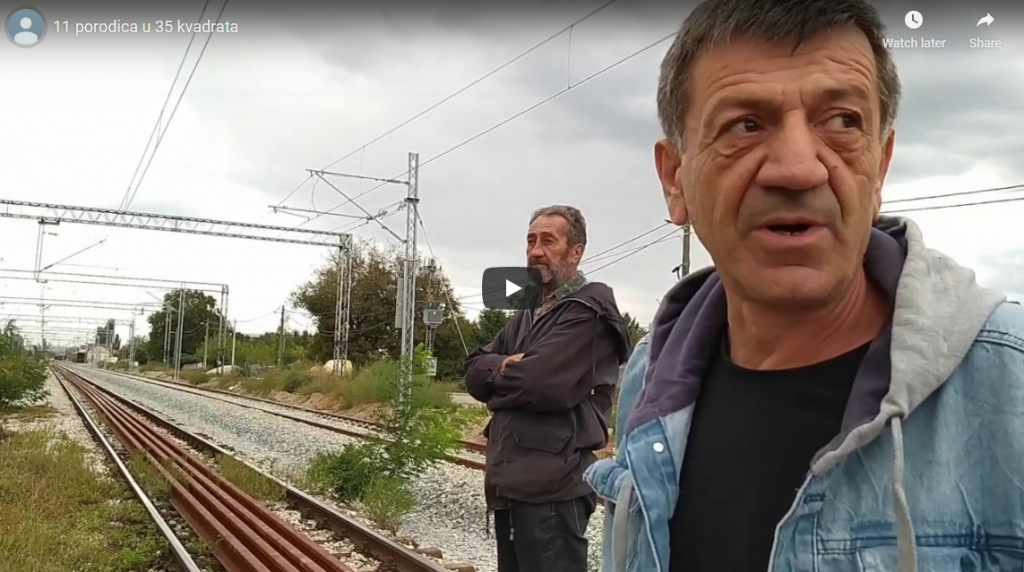
11 families in 35m2, a report by the activists of ZA Krov nad glavom (FOR the Roof Above Our Heads) organization. The families living near the railway that is being reconstructed are forced to move, without the state providing a replacement housing. Source: https://youtu.be/2Yz-gZ9aU_A
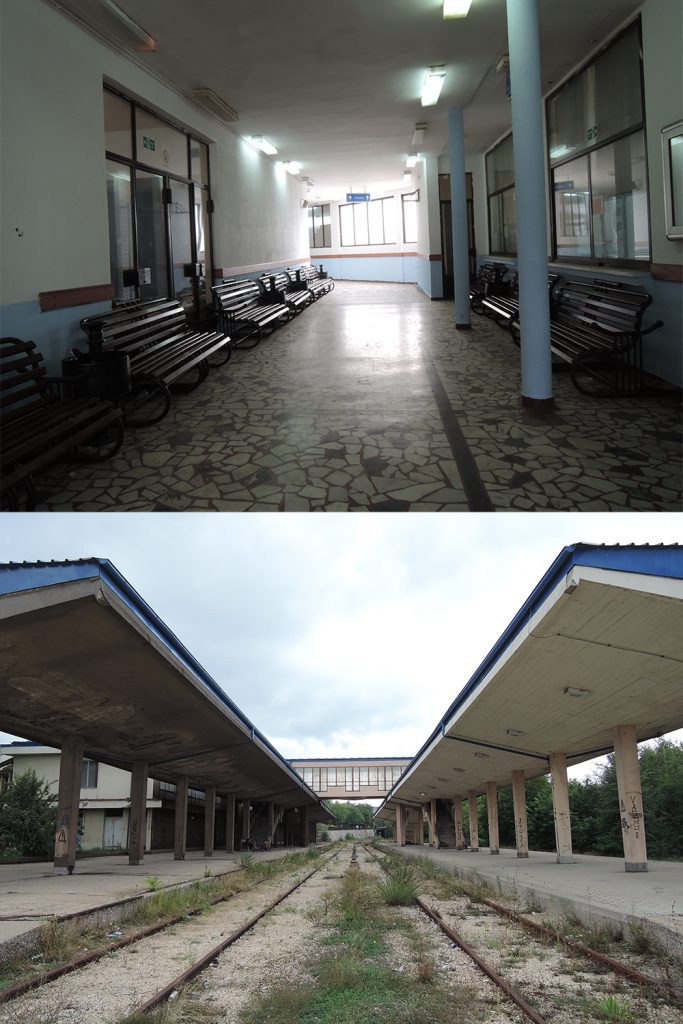
Main railway station in Bor 2020. Credit: Jelica Jovanović
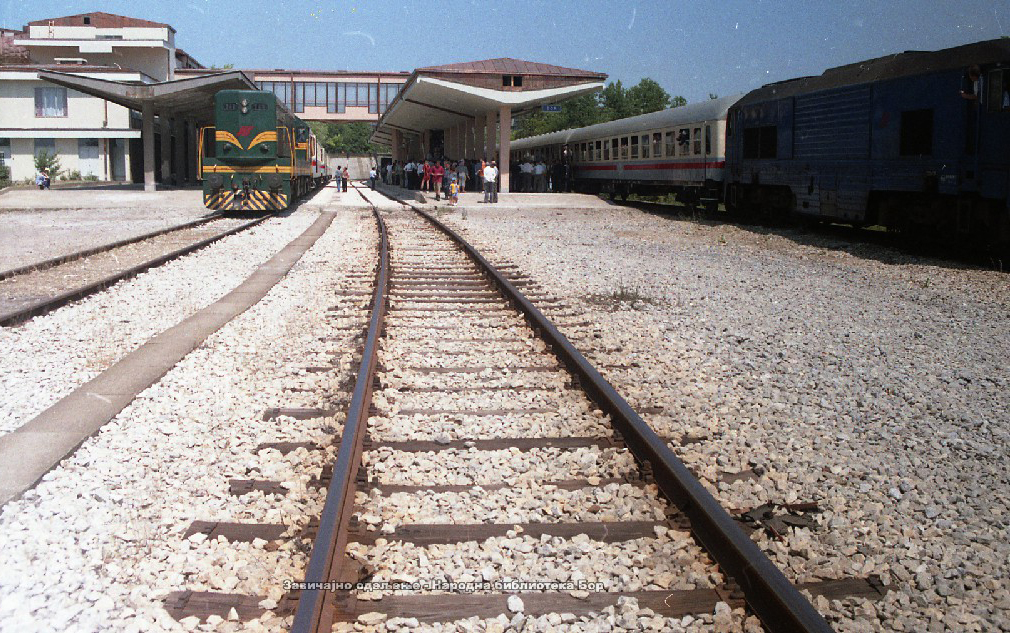
Main railway station in Bor circa 1980s. Courtesy National library Bor
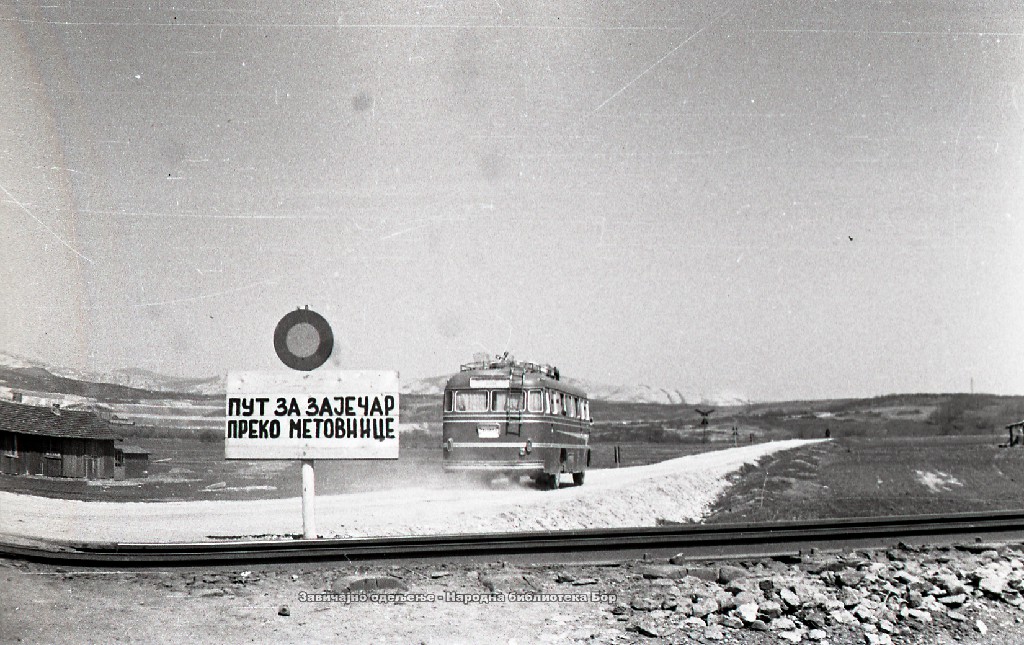
Road to Zaječar via Metovnica village, circa 1960. Courtesy National library Bor
A look towards the east of the country further complicates the picture. In stark contrast to the images of the Corridor 10 reconstruction are the haunting images of the empty train station in Bor. The last scheduled train departed from Bor train station on December 14th 2019, according to the schedule still hanging on the station’s walls. The railroad is working just fine and is still being used, but only for cargo trains, not passengers. The industrial railroad in Bor had already been dismantled a few years ago, with only one branch still in use within the Mining and Smelting Basin Bor, today known as Serbia Zijin Copper Doo Bor. The question of railroad construction in Eastern Serbia has always been a pressing matter for all the governments of Serbia/Yugoslavia, but most especially came to the fore in the second half of 19th century, to address the issue of connecting with the rest of the country via central route between Belgrade and Niš, when the road network to this area was too ineffective to meet the needs of the country. The ore extraction was the primary motif for the railroad construction in this region. Eastern Serbia, especially the Timok region, is very rich in mineral resources, as well as in agricultural products, which were necessary to boost the country’s economy that was always struggling with various crises. These respective industries have been considered a main branch of the economy since independence from the Ottoman empire.
In 1899, the government decided to sign a contract with some local entrepreneurs to build the railroad Paraćin-Zaječar. Due to the subsequent crisis regarding the parliament dismissal and a coup d’état, the beginning of the process was delayed until 1904. Although with many difficulties, especially since the terrain is very hilly and therefore difficult to build, the railroad was eventually finished and opened on January 1, 1911. Given the experience with Customs War/Pig War 1906-1908, Serbia was pushing for the construction of the railroads to ease itself from its dependence on the Austro-Hungarian empire. One of the results of this trade war was the development of the mining industry in Serbia – which then needed more ore, which came mostly from Eastern Serbia – and an effort to connect with the Thessaloniki port. However, this port was not entirely at the country’s disposal due to the influence of the court in Vienna, and Serbia consequently pushed for the construction of the more important Trans-Balkan railroad route along the Kladovo-Niš-Adriatic coast. As a part of this route, the railroad from Zaječar to Negotin was built, and by February 1914, it expanded further to Prahovo and the Port on Danube, as well as from Zaječar to Knjaževac by February 1915. These railroads further networked the region of Eastern Serbia, from which coal, iron, copper, and gold ore were being extracted7Nikolić, Jezdimir S.: Istorija železnica Srbije, Vojvodine, Crne Gore i Kosova, p. 157-162.
There have been several attempts to build more railroads in the more mountainous areas of Kučaj, which is also the area richest in gold, iron, and timber. A group of local merchants applied and got an approval of concession to build the railroad between Veliko Gradište on the Danube and Majdanpek, probably expecting that as concessionaries, it would also be easier for them to trade goods and raw materials if they had direct access to the port on the Danube. However, as it often happens, they overestimated their abilities and underestimated the challenges of the terrain and local microclimate. This railroad was never built8Ibid, p.163-164. Another very ambitious route that eventually was not finished as planned was the route Bor-Crni Vrh. The route was built under very peculiar circumstances: during the occupation by Nazi Germany, when the forced labour camp was established in Bor. Besides working in the mine, the prisoners were also building the route of the railroad from Bor to Crni Vrh, with the goal of easier extraction and transport of the timber and charcoal, and eventual continuation of the route to the town of Žagubica. The railroad was used as an industrial railroad with no travellers, but the problem with it was that it was built so poorly that accidents were constantly occurring. It was damaged before the retreat of the Nazi army – hence once the occupation was over in 1944, the first task that youth brigades had was to reconstruct this railroad. Within that year, the route was already partially in use, and by the summer of 1945, was finally completed and given to the Basin in Bor as an industrial railroad. It operated until 1968, when the need for it (and many other routes) ceased to exist, as motorways were in the process of being built9Radomir Cokić, B.Sc. eng. Forty years since the construction of the first youth railway Bor-Crni Vrh. http://timockapruga.org.rs/istorija_timockih_pruga/bor_crni_vrh.php, accessed Novemner 15, 2020. Today, only this route remains, with its rails removed, now used as a hiking trail.
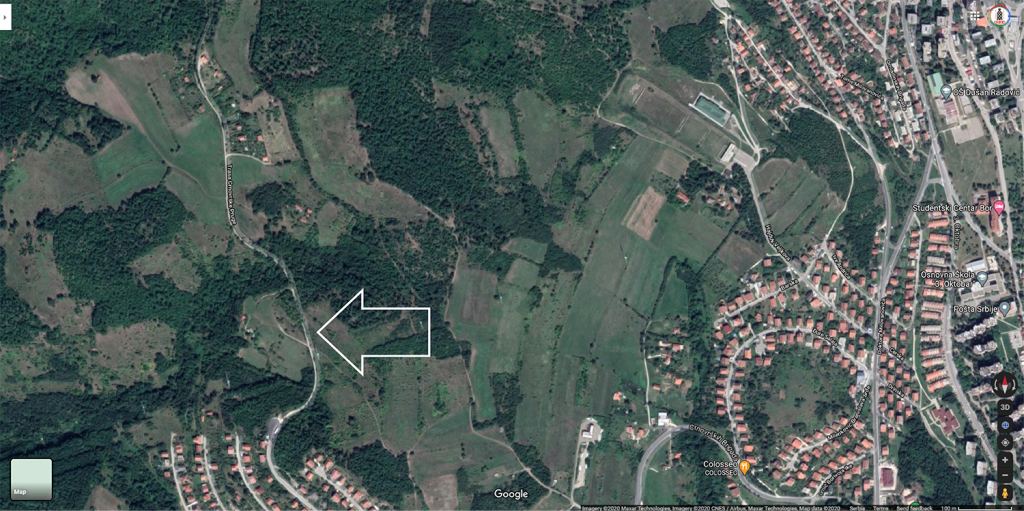

The route of the former railroad to Crni Vrh. Credit: Jelica Jovanović, October 2020.
Bor was one of the most important cities of the post-WW2 period in former Yugoslavia, precisely because of its material base: the copper mine. The town achieved the status of being a city in 1947 in order to establish the city’s status within the region, the republic, and the federation, as well as to give it the proper administrative basis for its future development. The copper served as one of the bases for the industrialization and electrification of the country, as well as lifting the population out of poverty. Copper mining and the expansion of copper production (as well as the other by-products, which are then further connected with other industries as the basis/resources for their production) were connected with the development of the city of Bor, as well as the development of the entire region and many other cities all over Serbia and into Yugoslavia. Within the broader region: Majdanpek, Zaječar, Boljevac, Kladovo, Negotin, Donji Milanovac, Prokuplje, Žagubica; within the Republic of Serbia: Novi Sad, Pančevo, Sevojno (near Užice), Jagodina; within Yugoslavia: Zagreb. The city’s mono-industry had essentially been under the auspices and control of the federal government from the very beginning of the socialist economy of Yugoslavia – even excluded to a certain degree from the framework of workers’ self-management, which was the official state polity10Jovanović, Jelica: EMERGING FROM THE ORE: BOR, A NEW CITY OF YUGOSLAVIA (manuscript for the catalog of the Pavilion of Serbia on 17th International Architecture Exhibition – Biennale in Venice).
Today, it feels that Bor, together with Serbia, has yet again found itself in a position similar to where it was a century (or at least 70 years) ago: deindustrialized, and reliant on direct foreign investments and foreign concessions to reconstruct its infrastructures and major industries. At the moment, nobody knows for certain what the terms of contract are in case of the railway reconstruction – or many other contracts as a matter of fact – and the general assumption is that they are unfavourable for Serbia, or else there would be no reason for confidentiality11Zorić, Ognjen: “Oznaka ‘Poverljivo’ – zašto tajnost prati ugovore koje sklapa Srbija?” [Label ‘Confidential’ – why does secrecy follow contracts concluded by Serbia?], https://www.slobodnaevropa.org/a/poverljivi-ugovori/30739667.html, accessed November 16th 2020. To help facilitate the process of direct bargaining with foreign creditors/investors, the government even pushed through parliament the Law on Special Procedures for the Implementation of the Project of Construction and Reconstruction of Line Infrastructure Structures of Particular Importance to the Republic of Serbia (Official Gazette of RS, number 9 from 04 February 2020). This law is targeting the so-called projects of construction and reconstruction of line infrastructure structures of particular importance to the Republic of Serbia – railways, highways, possibly the Belgrade metro – which are all currently being built with money given by foreign creditors, who in turn also bypass the local rules and laws on bidding, and directly negotiate for the companies from their countries of origin to come and build in Serbia. Meanwhile, the local construction companies have been ravaged by years of mismanagement and scandalously organized privatization. Hence the concern on how the debt will be repaid if the local industry is disappearing. However, very recent news show that China had started to suspend the debt for African countries, which in comparison to the usual money lenders, makes them a more desirable [business] partner, especially to the impoverished countries of the global South.12Jevans Nyabiage: Chinese bank signs debt suspension deals with 11 African countries, https://www.scmp.com/news/china/diplomacy/article/3105290/chinese-bank-signs-debt-suspension-deals-11-african-countries, accessed November 17, 2020
Although the contexts are different, maybe there is some room for renegotiating the terms of contracts in Serbia. In one of his lectures, Yanis Varoufakis reflects on his experience with the concession of the Pireaus Port, and states that there is a difference in the agendas of Western capital compared to Chinese capital entering foreign markets (being non-imperialistic/or less imperialistic), especially within the countries on the periphery of capitalism and the Global South like Ethiopia and Greece.13China vs EU on debt conditions. Source: https://www.youtube.com/watch?v=9tJatdtv4jQ&feature=emb_logo, accessed November 15, 2020 Serbia is in position very similar to these countries and it will be interesting to see how the situation will develop in the years to come.
Jelica Jovanović is an architect and PhD student at the University of Technology in Vienna, working as an independent researcher.
[1] Slobodna Evropa: „Kinesko čudo na Balkanu“ [A Chinese miracle in the Balkans] https://www.slobodnaevropa.org/a/30325861.html?utm_source=Balkan-HP-2col&utm_medium=banner&utm_campaign=China-vs-Balkans, accessed November 16th 2020
[2] World Bank: Economy Profile of Serbia Doing Business 2020 Indicators, p.3, https://www.doingbusiness.org/content/dam/doingBusiness/country/s/serbia/SRB.pdf, accessed November 16th 2020; Ministarstvo finansija RS: Javni dug Srbije, p.5, http://www.javnidug.gov.rs/upload/Stanje%20i%20struktura%20za%20mesecni%20izvestaj%20o%20stanju/31.12.2018%20final/Web%20site%20debt%20report%20%20-%20SRB%20LATINICA%20decenbar%20gotov.pdf, accessed November 17th 2020
[3] “Mihajlovićeva i Belozjorov potpisali sporazum o obnovi barske pruge do granice sa Crnom Gorom” [Mihajlovic and Belozjorov signed an agreement on recostruction of the Bar railway to the border with Montenegro],” Bilten, December 2019 – January 2020, p.3, http://www.zeleznicesrbije.com/wp-content/uploads/2020/01/bilten-decembar-januar-2020.pdf, accessed November 15, 2020
Aila Stojkobivić, “ARTICLE TITLE (SERBIAN)/(ENGLISH),” Bilten, September 2020, PAGE NUMBERhttp://www.zeleznicesrbije.com/wp-content/uploads/2020/09/bilten-septembar-2020.pdf
[4] Serbian Railways. History of Serbian Railways. http://www.zeleznicesrbije.com/istorijat/?lang=lat
[5] Economic Commission for Europe. International E Road Network. http://www.unece.org/fileadmin/DAM/trans/conventn/MapAGR2007.pdf , accessed November 15, 2020
[6] The brief report says: „…for a couple of months now, they have been exposed to pressure, attempts to cut off electricity, which they regularly pay for, as well as various forms of intimidation. Other families also received eviction orders, or were informally approached with such requests. In addition, all families have been living here for decades on the basis of a legally acquired right to use the accommodation, because their family members have spent their entire working life working for the railway and investing in its housing stock, as well as in the houses in which they lived. They do not want to move out until they are provided with adequate housing replacement, as required by the law. Everyone was offered the same thing: a smaller space in Topcider.“ ZA krov nad glavom: 11 porodica u 35 kvadrata, https://www.youtube.com/watch?v=2Yz-gZ9aU_A&feature=youtu.be, accessed November 17, 2020
[7] Nikolić, Jezdimir S.: Istorija železnica Srbije, Vojvodine, Crne Gore i Kosova, p. 157-162
[8] Ibid, p.163-164
[9] Radomir Cokić, B.Sc. eng. Forty years since the construction of the first youth railway Bor-Crni Vrh. http://timockapruga.org.rs/istorija_timockih_pruga/bor_crni_vrh.php, accessed Novemner 15, 2020
[10] Jovanović, Jelica: EMERGING FROM THE ORE: BOR, A NEW CITY OF YUGOSLAVIA (manuscript for the catalog of the Pavilion of Serbia on 17th International Architecture Exhibition – Biennale in Venice)
[11] Zorić, Ognjen: “Oznaka ‘Poverljivo’ – zašto tajnost prati ugovore koje sklapa Srbija?” [Label ‘Confidential’ – why does secrecy follow contracts concluded by Serbia?], https://www.slobodnaevropa.org/a/poverljivi-ugovori/30739667.html, accessed November 16th 2020
[12] Jevans Nyabiage: Chinese bank signs debt suspension deals with 11 African countries, https://www.scmp.com/news/china/diplomacy/article/3105290/chinese-bank-signs-debt-suspension-deals-11-african-countries, accessed November 17, 2020
[13] China vs EU on debt conditions. Source: https://www.youtube.com/watch?v=9tJatdtv4jQ&feature=emb_logo, accessed November 15, 2020
